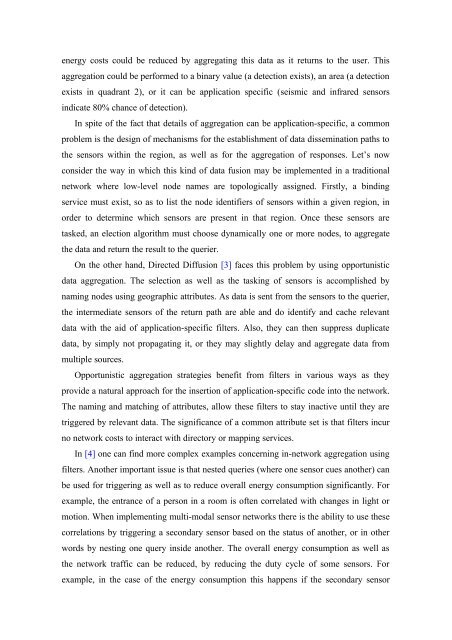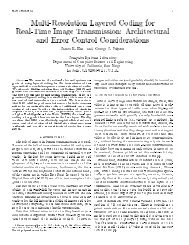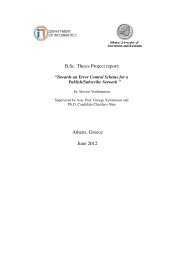In Network Processing and Data Aggregation in
In Network Processing and Data Aggregation in
In Network Processing and Data Aggregation in
You also want an ePaper? Increase the reach of your titles
YUMPU automatically turns print PDFs into web optimized ePapers that Google loves.
energy costs could be reduced by aggregat<strong>in</strong>g this data as it returns to the user. Thisaggregation could be performed to a b<strong>in</strong>ary value (a detection exists), an area (a detectionexists <strong>in</strong> quadrant 2), or it can be application specific (seismic <strong>and</strong> <strong>in</strong>frared sensors<strong>in</strong>dicate 80% chance of detection).<strong>In</strong> spite of the fact that details of aggregation can be application-specific, a commonproblem is the design of mechanisms for the establishment of data dissem<strong>in</strong>ation paths tothe sensors with<strong>in</strong> the region, as well as for the aggregation of responses. Let’s nowconsider the way <strong>in</strong> which this k<strong>in</strong>d of data fusion may be implemented <strong>in</strong> a traditionalnetwork where low-level node names are topologically assigned. Firstly, a b<strong>in</strong>d<strong>in</strong>gservice must exist, so as to list the node identifiers of sensors with<strong>in</strong> a given region, <strong>in</strong>order to determ<strong>in</strong>e which sensors are present <strong>in</strong> that region. Once these sensors aretasked, an election algorithm must choose dynamically one or more nodes, to aggregatethe data <strong>and</strong> return the result to the querier.On the other h<strong>and</strong>, Directed Diffusion [3] faces this problem by us<strong>in</strong>g opportunisticdata aggregation. The selection as well as the task<strong>in</strong>g of sensors is accomplished bynam<strong>in</strong>g nodes us<strong>in</strong>g geographic attributes. As data is sent from the sensors to the querier,the <strong>in</strong>termediate sensors of the return path are able <strong>and</strong> do identify <strong>and</strong> cache relevantdata with the aid of application-specific filters. Also, they can then suppress duplicatedata, by simply not propagat<strong>in</strong>g it, or they may slightly delay <strong>and</strong> aggregate data frommultiple sources.Opportunistic aggregation strategies benefit from filters <strong>in</strong> various ways as theyprovide a natural approach for the <strong>in</strong>sertion of application-specific code <strong>in</strong>to the network.The nam<strong>in</strong>g <strong>and</strong> match<strong>in</strong>g of attributes, allow these filters to stay <strong>in</strong>active until they aretriggered by relevant data. The significance of a common attribute set is that filters <strong>in</strong>curno network costs to <strong>in</strong>teract with directory or mapp<strong>in</strong>g services.<strong>In</strong> [4] one can f<strong>in</strong>d more complex examples concern<strong>in</strong>g <strong>in</strong>-network aggregation us<strong>in</strong>gfilters. Another important issue is that nested queries (where one sensor cues another) canbe used for trigger<strong>in</strong>g as well as to reduce overall energy consumption significantly. Forexample, the entrance of a person <strong>in</strong> a room is often correlated with changes <strong>in</strong> light ormotion. When implement<strong>in</strong>g multi-modal sensor networks there is the ability to use thesecorrelations by trigger<strong>in</strong>g a secondary sensor based on the status of another, or <strong>in</strong> otherwords by nest<strong>in</strong>g one query <strong>in</strong>side another. The overall energy consumption as well asthe network traffic can be reduced, by reduc<strong>in</strong>g the duty cycle of some sensors. Forexample, <strong>in</strong> the case of the energy consumption this happens if the secondary sensor








